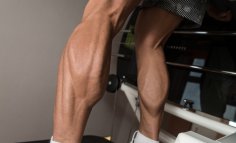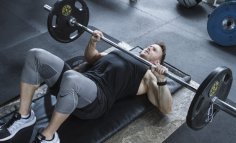 Visning av honn�rposter for oyvindskog Visning av honn�rposter for oyvindskog
|
|
Sider: 1 2 34
|
|
31
|
Trening / Kroppsbygging og Fitness / SV: Testo nivået synker om man driver styrketrening?
|
09. november 2006, 22:16
|
Følgende studie tyder på at fornuftig trening over tid gir en økning i testosteronverdier:
Neuromuscular and hormonal adaptations in athletes to strength training in two years
K. Hakkinen, A. Pakarinen, M. Alen, H. Kauhanen and P. V. Komi
Department of Biology of Physical Activity, University of Jyvaskyla, Finland.
Neuromuscular and hormonal adaptations to prolonged strength training were investigated in nine elite weight lifters. The average increases occurred over the 2-yr follow-up period in the maximal neural activation (integrated electromyogram, IEMG; 4.2%, P = NS), maximal isometric leg-extension force (4.9%, P = NS), averaged concentric power index (4.1%, P = NS), total weight-lifting result (2.8%, P less than 0.05), and total mean fiber area (5.9%, P = NS) of the vastus lateralis muscle, respectively. The training period resulted in increases in the concentrations of serum testosterone from 19.8 +/- 5.3 to 25.1 +/- 5.2 nmol/l (P less than 0.05), luteinizing hormone (LH) from 8.6 +/- 0.8 to 9.1 +/- 0.8 U/l (P less than 0.05), follicle-stimulating hormone (FSH) from 4.2 +/- 2.0 to 5.3 +/- 2.3 U/l (P less than 0.01), and testosterone-to-serum sex hormone-binding globulin (SHBG) ratio (P less than 0.05). The annual mean value of the second follow-up year for the serum testosterone-to-SHBG ratio correlated significantly (r = 0.84, P less than 0.01) with the individual changes during the 2nd yr in the averaged concentric power. The present results suggest that prolonged intensive strength training in elite athletes may influence the pituitary and possibly hypothalamic levels, leading to increased serum levels of testosterone. This may create more optimal conditions to utilize more intensive training leading to increased strength development.
Ved harde treningsperioder er det sannsynlig at testosteronverdiene vil gå ned. for så å øke igjen når man roer litt ned på treningen:
Hormonal adaptations and modelled responses in elite weightlifters during 6 weeks of training
T. Busso , K. Häkkinen, A. Pakarinen, H. Kauhanen, P. V. Komi and J. R. Lacour
The concentrations of serum testosterone, sex-hormone-binding-globulin (SHBG) and luteinizing hormone (LH) were examined throughout 1-year of training in six elite weightlifters. A systems model, providing an estimation of fatigue and fitness, was applied to records of training volume and performance levels in clean and jerk. The analysis focused on a 6-week training period during which blood samples were taken at 2-week intervals. A 4-week period of intensive training (period I) could be distinguished from the following 2-week period of reduced training (period II). During period I, decreases in serum testosterone (P<0.05) and increases in serum LH concentrations (P<0.01) were observed; a significant correlation (r=0.90,P<0.05) was also observed between the changes in serum LH concentration and in estimated fitness. The magnitude of LH response was not related to the change in serum androgens. On the other hand, the change in testosterone: SHBG ratio during period II was significantly correlated (r=0.97,P<0.01) to the LH variations during period I. These finding suggested that the LH response indicated that the decrease in testosterone concentration was not primarily due to a dysfunction of the hypothalamic-pituitary system control, and that the fatigue/fitness status of an athlete could have influenced the LH response to the decreased testosterone concentration. The negative effect of training on hormonal balance could have been amplified by its influence on the hypothalamic-pituitary axis. A decrease in physiological stress would thus have been necessary for the completion of the effect of LH release on androgenic activity.
|
| Honn�r gitt av : Baahh, 09. november 2006, 23:12
|
|
|
32
|
Trening / Styrkeløft / SV: dype knebøy
|
17. oktober 2006, 21:56
|
Utdrag fra et innlegg av Arioch og Spatts på elitefitness.com angående dybde på knebøy:
http://www.elitefitness.com/forum/showthread.php?t=332299
There are several schools of thought on squat depth. Many misinformed individuals caution against squatting below parallel, stating that this is hazardous to the knees. Nothing could be further from the truth. (2) Stopping at or above parallel places direct stress on the knees, whereas a deep squat will transfer the load to the hips,(3) which are capable of handling a greater amount of force than the knees should ever be exposed to. Studies have shown that the squat produces lower peak tibeo-femoral(stress at the knee joint) compressive force than both the leg press and the leg extension.(4) For functional strength, one should descend as deeply as possible, and under control. (yes, certain individuals can squat in a ballistic manner, but they are the exception rather than the rule). The further a lifter descends, the more the hamstrings are recruited, and proper squatting displays nearly twice the hamstring involvement of the leg press or leg extension. (5,6) and as one of the functions of the hamstring is to protect the patella tendon (the primary tendon involved in knee extension) during knee extension through a concurrent firing process, the greatest degree of hamstring recruitment should provide the greatest degree of protection to the knee joint. (7) When one is a powerlifter, the top surface of the legs at the hip joint must descend to a point below the top surface of the legs at the knee joint.
Knee injuries are one of the most commonly stated problems that come from squatting, however, this is usually stated by those who do not know how to squat. A properly performed squat will appropriately load the knee joint, which improves congruity by increasing the compressive forces at the knee joint. (8,(9) which improves stability, protecting the knee against shear forces. As part of a long-term exercise program, the squat, like other exercises, will lead to increased collagen turnover and hypertrophy of ligaments. (10,11) At least one study has shown that international caliber weightlifters and powerlifters experience less clinical or symptomatic arthritis. (12) Other critics of the squat have stated that it decreases the stability of the knees, yet nothing could be further from the truth. Studies have shown that the squat will increase knee stability by reducing joint laxity, as well as decrease anterior-posterior laxity and translation. (13,14) The squat is, in fact, being used as a rehabilitation exercise for many types of knee injuries, including ACL repair. (15)
2 Ariel, B.G., 1974. Biomechanical analysis of the knee joint during deep knee bends with a heavy load. Biomechanics. IV(1):44-52.
3 High- and low-bar squatting techniques during weight-training. Wretenberg P; Feng Y; Arborelius UP, Med Sci Sports Exerc, 28(2):218-24 1996 Feb
4 An analytical model of the knee for estimation of internal forces during exercise. Zheng N; Fleisig GS; Escamilla RF; Barrentine SW, J Biomech, 31(10):963-7 1998 Oct
5 Biomechanics of the knee during closed kinetic chain and open kinetic chain exercises. Escamilla RF; Fleisig GS; Zheng N; Barrentine SW; Wilk KE; Andrews JR Med Sci Sports Exerc, 30(4):556-69 1998 Apr
6 A comparison of tibiofemoral joint forces and electromyographic activity during open and closed kinetic chain exercises. Wilk KE; Escamilla RF; Fleisig GS; Barrentine SW; Andrews JR; Boyd ML Am J Sports Med, 24(4):518-27 1996 Jul-Aug
7 Chandler TJ and Stone MH. (1991) The squat exercise in athletic conditioning: a review of the literature. NSCA Journal. 13(5): 58-60.
8 Hsieh, H. and P.S. Walker. 1976. Stabilizing mechanisms of the loaded and unloaded knee joint. Journal of Bone and Joint Surgery. 58A(1):87-93.
9 Uhl, T.L. and P.V. Loubert. 1990. Axial compression effect on anterior displacement of the in vivo tibeofemoral joint. Master’s thesis, University of Michigan, Ann Arbor, MI.
10 Shankman, G. 1989. Training guidelines for strengthening the injured knee: basic concepts for the strength coach. NSCA Journal. 11(4):32-42.
11 Tipton, C.M., Matthes, R.D., Maynard, J.A. and Carey, R.A. 1975. The influence of physical activity on ligaments and tendons. Medicine and Science in Sports. 7(3):165-175.
12 Herrick, R.T., Stone, M.H. and Herrick, S. 1983. Injuries in strength-power activities. Powerlifting USA. 7(5):7-9.
13 Panariello, R.A., Backus, S.I., and Parker, J.W. 1994. The effect of the squat exercise on anterior-posterior knee translation in professional football players. American Journal of Sports Medicine. 22(6):768-773.
14 Steiner, M.E., Grana, W.A., Chillag, K., and Schelberg-Karnes, E. The effect of exercise on anterior-posterior knee laxity. 1986. American Journal of Sports Medicine. 14(1): 24-29.
15 Palmitier, R.A., Kai-Nan, A., Scott, S.G., and Chao, E.Y.S. 1991. Kinetic chain exercise in knee rehabilitation. Sports Medicine. 11(6):402-413. |
| Honn�r gitt av : Rørosingen, 18. oktober 2006, 11:55
|
|
|
33
|
Trening / Styrkeløft / SV: dype knebøy
|
17. oktober 2006, 21:56
|
Utdrag fra et innlegg av Arioch og Spatts på elitefitness.com angående dybde på knebøy:
http://www.elitefitness.com/forum/showthread.php?t=332299
There are several schools of thought on squat depth. Many misinformed individuals caution against squatting below parallel, stating that this is hazardous to the knees. Nothing could be further from the truth. (2) Stopping at or above parallel places direct stress on the knees, whereas a deep squat will transfer the load to the hips,(3) which are capable of handling a greater amount of force than the knees should ever be exposed to. Studies have shown that the squat produces lower peak tibeo-femoral(stress at the knee joint) compressive force than both the leg press and the leg extension.(4) For functional strength, one should descend as deeply as possible, and under control. (yes, certain individuals can squat in a ballistic manner, but they are the exception rather than the rule). The further a lifter descends, the more the hamstrings are recruited, and proper squatting displays nearly twice the hamstring involvement of the leg press or leg extension. (5,6) and as one of the functions of the hamstring is to protect the patella tendon (the primary tendon involved in knee extension) during knee extension through a concurrent firing process, the greatest degree of hamstring recruitment should provide the greatest degree of protection to the knee joint. (7) When one is a powerlifter, the top surface of the legs at the hip joint must descend to a point below the top surface of the legs at the knee joint.
Knee injuries are one of the most commonly stated problems that come from squatting, however, this is usually stated by those who do not know how to squat. A properly performed squat will appropriately load the knee joint, which improves congruity by increasing the compressive forces at the knee joint. (8,(9) which improves stability, protecting the knee against shear forces. As part of a long-term exercise program, the squat, like other exercises, will lead to increased collagen turnover and hypertrophy of ligaments. (10,11) At least one study has shown that international caliber weightlifters and powerlifters experience less clinical or symptomatic arthritis. (12) Other critics of the squat have stated that it decreases the stability of the knees, yet nothing could be further from the truth. Studies have shown that the squat will increase knee stability by reducing joint laxity, as well as decrease anterior-posterior laxity and translation. (13,14) The squat is, in fact, being used as a rehabilitation exercise for many types of knee injuries, including ACL repair. (15)
2 Ariel, B.G., 1974. Biomechanical analysis of the knee joint during deep knee bends with a heavy load. Biomechanics. IV(1):44-52.
3 High- and low-bar squatting techniques during weight-training. Wretenberg P; Feng Y; Arborelius UP, Med Sci Sports Exerc, 28(2):218-24 1996 Feb
4 An analytical model of the knee for estimation of internal forces during exercise. Zheng N; Fleisig GS; Escamilla RF; Barrentine SW, J Biomech, 31(10):963-7 1998 Oct
5 Biomechanics of the knee during closed kinetic chain and open kinetic chain exercises. Escamilla RF; Fleisig GS; Zheng N; Barrentine SW; Wilk KE; Andrews JR Med Sci Sports Exerc, 30(4):556-69 1998 Apr
6 A comparison of tibiofemoral joint forces and electromyographic activity during open and closed kinetic chain exercises. Wilk KE; Escamilla RF; Fleisig GS; Barrentine SW; Andrews JR; Boyd ML Am J Sports Med, 24(4):518-27 1996 Jul-Aug
7 Chandler TJ and Stone MH. (1991) The squat exercise in athletic conditioning: a review of the literature. NSCA Journal. 13(5): 58-60.
8 Hsieh, H. and P.S. Walker. 1976. Stabilizing mechanisms of the loaded and unloaded knee joint. Journal of Bone and Joint Surgery. 58A(1):87-93.
9 Uhl, T.L. and P.V. Loubert. 1990. Axial compression effect on anterior displacement of the in vivo tibeofemoral joint. Master’s thesis, University of Michigan, Ann Arbor, MI.
10 Shankman, G. 1989. Training guidelines for strengthening the injured knee: basic concepts for the strength coach. NSCA Journal. 11(4):32-42.
11 Tipton, C.M., Matthes, R.D., Maynard, J.A. and Carey, R.A. 1975. The influence of physical activity on ligaments and tendons. Medicine and Science in Sports. 7(3):165-175.
12 Herrick, R.T., Stone, M.H. and Herrick, S. 1983. Injuries in strength-power activities. Powerlifting USA. 7(5):7-9.
13 Panariello, R.A., Backus, S.I., and Parker, J.W. 1994. The effect of the squat exercise on anterior-posterior knee translation in professional football players. American Journal of Sports Medicine. 22(6):768-773.
14 Steiner, M.E., Grana, W.A., Chillag, K., and Schelberg-Karnes, E. The effect of exercise on anterior-posterior knee laxity. 1986. American Journal of Sports Medicine. 14(1): 24-29.
15 Palmitier, R.A., Kai-Nan, A., Scott, S.G., and Chao, E.Y.S. 1991. Kinetic chain exercise in knee rehabilitation. Sports Medicine. 11(6):402-413. |
| Honn�r gitt av : AgentOrange, 18. oktober 2006, 05:46
|
|
|
34
|
Trening / Styrkeløft / SV: dype knebøy
|
17. oktober 2006, 21:56
|
Utdrag fra et innlegg av Arioch og Spatts på elitefitness.com angående dybde på knebøy:
http://www.elitefitness.com/forum/showthread.php?t=332299
There are several schools of thought on squat depth. Many misinformed individuals caution against squatting below parallel, stating that this is hazardous to the knees. Nothing could be further from the truth. (2) Stopping at or above parallel places direct stress on the knees, whereas a deep squat will transfer the load to the hips,(3) which are capable of handling a greater amount of force than the knees should ever be exposed to. Studies have shown that the squat produces lower peak tibeo-femoral(stress at the knee joint) compressive force than both the leg press and the leg extension.(4) For functional strength, one should descend as deeply as possible, and under control. (yes, certain individuals can squat in a ballistic manner, but they are the exception rather than the rule). The further a lifter descends, the more the hamstrings are recruited, and proper squatting displays nearly twice the hamstring involvement of the leg press or leg extension. (5,6) and as one of the functions of the hamstring is to protect the patella tendon (the primary tendon involved in knee extension) during knee extension through a concurrent firing process, the greatest degree of hamstring recruitment should provide the greatest degree of protection to the knee joint. (7) When one is a powerlifter, the top surface of the legs at the hip joint must descend to a point below the top surface of the legs at the knee joint.
Knee injuries are one of the most commonly stated problems that come from squatting, however, this is usually stated by those who do not know how to squat. A properly performed squat will appropriately load the knee joint, which improves congruity by increasing the compressive forces at the knee joint. (8,(9) which improves stability, protecting the knee against shear forces. As part of a long-term exercise program, the squat, like other exercises, will lead to increased collagen turnover and hypertrophy of ligaments. (10,11) At least one study has shown that international caliber weightlifters and powerlifters experience less clinical or symptomatic arthritis. (12) Other critics of the squat have stated that it decreases the stability of the knees, yet nothing could be further from the truth. Studies have shown that the squat will increase knee stability by reducing joint laxity, as well as decrease anterior-posterior laxity and translation. (13,14) The squat is, in fact, being used as a rehabilitation exercise for many types of knee injuries, including ACL repair. (15)
2 Ariel, B.G., 1974. Biomechanical analysis of the knee joint during deep knee bends with a heavy load. Biomechanics. IV(1):44-52.
3 High- and low-bar squatting techniques during weight-training. Wretenberg P; Feng Y; Arborelius UP, Med Sci Sports Exerc, 28(2):218-24 1996 Feb
4 An analytical model of the knee for estimation of internal forces during exercise. Zheng N; Fleisig GS; Escamilla RF; Barrentine SW, J Biomech, 31(10):963-7 1998 Oct
5 Biomechanics of the knee during closed kinetic chain and open kinetic chain exercises. Escamilla RF; Fleisig GS; Zheng N; Barrentine SW; Wilk KE; Andrews JR Med Sci Sports Exerc, 30(4):556-69 1998 Apr
6 A comparison of tibiofemoral joint forces and electromyographic activity during open and closed kinetic chain exercises. Wilk KE; Escamilla RF; Fleisig GS; Barrentine SW; Andrews JR; Boyd ML Am J Sports Med, 24(4):518-27 1996 Jul-Aug
7 Chandler TJ and Stone MH. (1991) The squat exercise in athletic conditioning: a review of the literature. NSCA Journal. 13(5): 58-60.
8 Hsieh, H. and P.S. Walker. 1976. Stabilizing mechanisms of the loaded and unloaded knee joint. Journal of Bone and Joint Surgery. 58A(1):87-93.
9 Uhl, T.L. and P.V. Loubert. 1990. Axial compression effect on anterior displacement of the in vivo tibeofemoral joint. Master’s thesis, University of Michigan, Ann Arbor, MI.
10 Shankman, G. 1989. Training guidelines for strengthening the injured knee: basic concepts for the strength coach. NSCA Journal. 11(4):32-42.
11 Tipton, C.M., Matthes, R.D., Maynard, J.A. and Carey, R.A. 1975. The influence of physical activity on ligaments and tendons. Medicine and Science in Sports. 7(3):165-175.
12 Herrick, R.T., Stone, M.H. and Herrick, S. 1983. Injuries in strength-power activities. Powerlifting USA. 7(5):7-9.
13 Panariello, R.A., Backus, S.I., and Parker, J.W. 1994. The effect of the squat exercise on anterior-posterior knee translation in professional football players. American Journal of Sports Medicine. 22(6):768-773.
14 Steiner, M.E., Grana, W.A., Chillag, K., and Schelberg-Karnes, E. The effect of exercise on anterior-posterior knee laxity. 1986. American Journal of Sports Medicine. 14(1): 24-29.
15 Palmitier, R.A., Kai-Nan, A., Scott, S.G., and Chao, E.Y.S. 1991. Kinetic chain exercise in knee rehabilitation. Sports Medicine. 11(6):402-413. |
| Honn�r gitt av : Benpressmannen, 17. oktober 2006, 22:45
|
|
|
35
|
Trening / Styrkeløft / SV: dype knebøy
|
17. oktober 2006, 21:56
|
Utdrag fra et innlegg av Arioch og Spatts på elitefitness.com angående dybde på knebøy:
http://www.elitefitness.com/forum/showthread.php?t=332299
There are several schools of thought on squat depth. Many misinformed individuals caution against squatting below parallel, stating that this is hazardous to the knees. Nothing could be further from the truth. (2) Stopping at or above parallel places direct stress on the knees, whereas a deep squat will transfer the load to the hips,(3) which are capable of handling a greater amount of force than the knees should ever be exposed to. Studies have shown that the squat produces lower peak tibeo-femoral(stress at the knee joint) compressive force than both the leg press and the leg extension.(4) For functional strength, one should descend as deeply as possible, and under control. (yes, certain individuals can squat in a ballistic manner, but they are the exception rather than the rule). The further a lifter descends, the more the hamstrings are recruited, and proper squatting displays nearly twice the hamstring involvement of the leg press or leg extension. (5,6) and as one of the functions of the hamstring is to protect the patella tendon (the primary tendon involved in knee extension) during knee extension through a concurrent firing process, the greatest degree of hamstring recruitment should provide the greatest degree of protection to the knee joint. (7) When one is a powerlifter, the top surface of the legs at the hip joint must descend to a point below the top surface of the legs at the knee joint.
Knee injuries are one of the most commonly stated problems that come from squatting, however, this is usually stated by those who do not know how to squat. A properly performed squat will appropriately load the knee joint, which improves congruity by increasing the compressive forces at the knee joint. (8,(9) which improves stability, protecting the knee against shear forces. As part of a long-term exercise program, the squat, like other exercises, will lead to increased collagen turnover and hypertrophy of ligaments. (10,11) At least one study has shown that international caliber weightlifters and powerlifters experience less clinical or symptomatic arthritis. (12) Other critics of the squat have stated that it decreases the stability of the knees, yet nothing could be further from the truth. Studies have shown that the squat will increase knee stability by reducing joint laxity, as well as decrease anterior-posterior laxity and translation. (13,14) The squat is, in fact, being used as a rehabilitation exercise for many types of knee injuries, including ACL repair. (15)
2 Ariel, B.G., 1974. Biomechanical analysis of the knee joint during deep knee bends with a heavy load. Biomechanics. IV(1):44-52.
3 High- and low-bar squatting techniques during weight-training. Wretenberg P; Feng Y; Arborelius UP, Med Sci Sports Exerc, 28(2):218-24 1996 Feb
4 An analytical model of the knee for estimation of internal forces during exercise. Zheng N; Fleisig GS; Escamilla RF; Barrentine SW, J Biomech, 31(10):963-7 1998 Oct
5 Biomechanics of the knee during closed kinetic chain and open kinetic chain exercises. Escamilla RF; Fleisig GS; Zheng N; Barrentine SW; Wilk KE; Andrews JR Med Sci Sports Exerc, 30(4):556-69 1998 Apr
6 A comparison of tibiofemoral joint forces and electromyographic activity during open and closed kinetic chain exercises. Wilk KE; Escamilla RF; Fleisig GS; Barrentine SW; Andrews JR; Boyd ML Am J Sports Med, 24(4):518-27 1996 Jul-Aug
7 Chandler TJ and Stone MH. (1991) The squat exercise in athletic conditioning: a review of the literature. NSCA Journal. 13(5): 58-60.
8 Hsieh, H. and P.S. Walker. 1976. Stabilizing mechanisms of the loaded and unloaded knee joint. Journal of Bone and Joint Surgery. 58A(1):87-93.
9 Uhl, T.L. and P.V. Loubert. 1990. Axial compression effect on anterior displacement of the in vivo tibeofemoral joint. Master’s thesis, University of Michigan, Ann Arbor, MI.
10 Shankman, G. 1989. Training guidelines for strengthening the injured knee: basic concepts for the strength coach. NSCA Journal. 11(4):32-42.
11 Tipton, C.M., Matthes, R.D., Maynard, J.A. and Carey, R.A. 1975. The influence of physical activity on ligaments and tendons. Medicine and Science in Sports. 7(3):165-175.
12 Herrick, R.T., Stone, M.H. and Herrick, S. 1983. Injuries in strength-power activities. Powerlifting USA. 7(5):7-9.
13 Panariello, R.A., Backus, S.I., and Parker, J.W. 1994. The effect of the squat exercise on anterior-posterior knee translation in professional football players. American Journal of Sports Medicine. 22(6):768-773.
14 Steiner, M.E., Grana, W.A., Chillag, K., and Schelberg-Karnes, E. The effect of exercise on anterior-posterior knee laxity. 1986. American Journal of Sports Medicine. 14(1): 24-29.
15 Palmitier, R.A., Kai-Nan, A., Scott, S.G., and Chao, E.Y.S. 1991. Kinetic chain exercise in knee rehabilitation. Sports Medicine. 11(6):402-413. |
| Honn�r gitt av : BadBoy, 17. oktober 2006, 22:21
|
|
|
36
|
Generelt / Loggbok Online / SV: Ukkurs trenings- og bildelogg
|
17. oktober 2006, 18:20
|
Føler jeg står på stedet hvil, irriterende.
Prøv å gå litt tilbake for å hente tilfart. Når man har blitt såpass sterk som du funker det dårlig å gå til max hver økt. Kjør 5x5 på 60kg eller noe i benk og øk 2,5kg i uka. |
| Honn�r gitt av : Benpressmannen, 17. oktober 2006, 19:11
|
|
|
38
|
Trening / Forum for nybegynnere / SV: Nedtrekk foran eller bak?
|
19. september 2006, 20:29
|
Det eg meinte med anatomiske begrensniger, noko som eg trur du skjønte  , var at ved desse posisjonene vil ein utsette skulderen og nakke først og fremst for ein unormal og lite anatomisk gunstig posisjon som vil kunne skape ein større mulighet for skader. Og sjølvsagt er menneske kroppen veldig fleksibel på den måten at vi kan jobbe i slike ugunstige posisjoner over tid uten skader, men det kan sjølvsagt komme skader også. Dessuten, dei aller aller fleste som har lest og forstått kroppens anatomi og rørelsemønster vil forstå at ved dei posisjonene vil ein utsette kroppen for ein rørelse som den ikkje er skapt for. Dermed vil det bli ein større mulighet for skader Er vel derfor eg har behandla så mange med slike skuldrer og nakker  Kan berre sjå tilbake til steinalderen, vi henta ikkje epler ned frå trærene bak nakken, men framfor slik at vi skulle sjå ka vi plukka ned frå træra, ergo ingen nedtrekk bak :  Enig i at kroppen slites meir eller mindre ut i alle ledd. Hadde jo vert kjekt å foretatt ein MRT(magnetresonans tomografi) og vanlig røntgen av samtlige her på treningsforum for å sett kor mange som har degenerative forandringer i f.eks ryggraden. Tipper at det er mange, sjølv om dei færreste her har problemer i ryggen  Eg måtte berre svare 
Ser du noen verdi i å forberede kroppen på anatomisk ugunstige posisjoner for å forebygge skader? For min egen del er nedtrekk bak nakken samt press bak nakken med bredt grep noe jeg gjør til en viss del for å holde skuldrene friske. Jeg mener faktisk at disse to øvelsene har vært med å hjelpe meg til å kunne kjøre benkpress med bredt grep uten smerter i skuldra, noe jeg i mange år hadde problemer med. I tillegg hjelper de meg å få armene ned i posisjon for knebøy relativt komfortabelt. Jeg gjør selvfølgelig ikke disse øvelsene med tunge vekter, men jeg ser ikke helt på nedtrekk av noen form som øvelser man typisk kjører tungt.
Jeg tror heller ikke at de plukket ned epler bak nakken i steinalderen men jeg er sikker på at de kastet saker og ting. For meg er posisjonen i det jeg drar hånda bakover for å kaste noe temmelig lik posisjonen i nedtrekk bak nakken. Når dette er sagt vet jeg såpass lite om hvordan livet artet seg i steinalderen at jeg sjelden lar dette påvirke hvordan jeg trener.
Når det gjelder risiko forbundet med forskjellige øvelser synes jeg følgende innlegg av avdøde Mel Siff er meget bra:
DANGEROUS EXERCISES?
From: Mcsiff@aol.com
Date: Tue, 7 Sep 1999 07:23:40 -0700
Recently there has been some comment on the dangers of lat pulldowns behind the neck, since some authorities believe that they causes shoulder injuries.
However, it is not just that any exercise is dangerous, but that there are
'right' and 'wrong' ways for any given individual to execute every
exercise. There has been quite a trend today to simplify the cause of
injuries into neat little formulae that run something like this:
* Squats are bad for the knees
* Deadlifts and cleans are bad for the back
* Belts weaken the back
* Muscle imbalances are a major cause of injury
* Lat pulls downs behind the neck are dangerous
* Ballistic movements are dangerous
* Plyometrics are dangerous
We have heard all of these proclamations - what else is new? There is a
list of over 200 such myths and misbeliefs in my book "Facts & Fallacies of
Fitness", so the above few examples are by no means even vaguely complete - and I am sure than many of you could add your own real gems.
Although in several cases there are indeed exercises that tend to be more demanding or skillful than others and therefore carry a higher risk of injury for the average person, it is incorrect to maintain that a given
exercise is dangerous, bad or inadvisable. To a large extent, the risks
attached to any exercise (and that even includes the most basic acts of
sitting, standing, walking and running) are also the result of poor
technique.
Nobody has been able to furnish any documented scientific or clinical
evidence that the lat pulldown behind the head per se is a dangerous
exercise and that it constitutes a significant cause of shoulder injury.
All that we have seen are opinions or theoretical attempts to justify
opinions on the basis of personal interpretations of apparently relevant
functional biomechanics.
This lack of any compelling evidence is not unexpected, since cause of
injury is not just a matter of alleged muscle imbalances (though sometimes these may occur) or the inherent risks of certain exercises. Injury may be due to several factors, including (Siff & Verkhoshansky "Supertraining" 1999 Ch 8):
* faulty technique for that individual
* the after-effects of preceding exercises
* the presence of fatigue in stabilising or synergistic muscles
* loss of concentration or motivation
* the existence of spurious, "non-functional" muscle tension
* the use of inappropriate soft tissues (e.g. ligaments) to control a
movement
* excessive loading
* excessively long loading
* inappropriate patterns of movement
* excessive acceleration or deceleration at a during a given phase of an
exercise
* inappropriate breath control for stabilisation or mobilisation
For these and other reasons, one needs to be very cautious in claiming that a given exercise is inherently dangerous for everyone or stating that
traditional isolationist or isokinetic muscle tests will help reveal who is
susceptible to certain types of injury.
For instance, a few training colleagues and I used to do lat pulldowns
behind the neck with around 120kg or 264lbs for 3 sets of 10 reps quite
often and never ever experienced problems with our shoulders. Of course, I would be the first to admit that we paid careful attention to technique, loading and focus. I also did explosive, ballistic standing presses with between 115-122 kg (240-270lbs) for many years (and I still do), at least twice a week, using the classical two phase back bend style (double 'hyperextension') and never ever experienced the oft-predicted back trauma - nor did any others who competed in this lift with or against me during all that time.
This does not mean that we totally refuted all negative criticism and that
the standing press or lat pulldowns behind the neck are very safe with even large loads - it just illustrates that most exercises can be done safely or unsafely by a given individual at a given time. Blanket rules and
soothsayers of doom are just waiting to be proved wrong every step of the way. Let us just remember that there are general guidelines for every exercise, but that these need to be applied in the context of the
individual, the situation and the timing. After all, rules are just
waiting to be ruled against!
Dr Mel C Siff
Denver, USA
Følgende innlegg også av Mel Siff tar for seg risikoen ved nedtrekk bak nakken mer spesifikt:
Date: Sat, 11 Sep 1999 23:58:41 EDT
From: Mcsiff@aol.com
Subject: Strength_List: LAT PULLDOWNS
Several comments on the alleged dangers of behind the neck (BTN) pulldowns presume that this necessarily causes excessive lateral rotation of the humerus. While this certainly may be the case with some ways of BTN pulling, it is not always true of all methods of BTN pulling, such as those used when:
1. You sit very close to the pullup machine so that you can pull the load
directly downwards, thereby not producing any externally rotating torque
about the shoulder joint
2. You face the pullup machine and lean forwards so that you can pull the load down at an angle which minimises the tendency to external rotation of the shoulder.
While I have no particular affection for the BTN exercise and see no really
compelling reason to use it regularly in place of the wide variety of
pulldowns in front of the neck (except possibly to offer one form of training adaptation to external shoulder rotation which occurs in many throwing activities), one still should not attribute specific injuries to any single given exercise like this, when the risks may be more closely related to the manner in which that exercise is executed or prescribed.
Possibly pulldowns, like power cleans, standing presses, presses behind the neck, good mornings, snatches and full squats indeed are easier to perform incorrectly for relative novices, but this does not mean that they cannot be executed very safely and effectively, if care is taken to learn them correctly to suit your specific structure.
If one examines the clinical records of sports physical therapists and
orthopaedic surgeons, it is far more likely that you will find far more
shoulder injuries that are caused by common popular sporting activities like baseball and other throwing and hitting sports than by BTN pulldowns among bodybuilders.
Many colleagues of mine and I have trained or trained with numerous
bodybuilders, athletes and pretty average clients who have used BTN
pulldowns for many years without injury, so the 'workplace' does not suggest that there is a major epidemic of shoulder injuries resulting from this exercise. I am still curious to see peer-reviewed references which provide clinical proof that a significant number of shoulder injuries correlate with the use of judiciously performed BTN pulldowns.
Those who contend that the BTN pulldown produces excessive force in the anterior structures of the shoulder need to sketch a free body mechanical diagram to note that the shoulder joint is not passively forced into significant external rotation if the load is pulled vertically downwards
(thus there is no force component to produce a moment that results in any form of rotation of the shoulder). In other words, the argument concerning excessive lateral rotation of the humerus is concerned more with faulty technique than a faulty exercise.
Dr Mel C Siff
Denver, USA
|
| Honn�r gitt av : Benpressmannen, 19. september 2006, 20:41
|
|
|
39
|
Trening / 5x5 / SV: Powerbuilding uten skulderpress
|
26. august 2006, 08:03
|
Jeg ville ha putta inn tung roing på den dagen hvis jeg hadde vondt i skuldrene.
Når dette er sagt bør jo målet være å bli i stand til å presse over hodet uten smerter.
Prøv å kjør press over hodet veldig lett på slutten av økta. Hvis det gjør vondt går du ned på vektene. Bruk et kosteskaft hvis det er nødvendig.
Hvis du sitter når du presser kan du prøve å stå i steden. Det er min erfaring at press over hodet gnager mye mer på skuldrene når man har ryggstøtte.
Jeg tror også scarecrow øvelsen fra denne artikkelen vil være nyttig:
http://www.t-nation.com/readTopic.do?id=459846
(Alle øvelsene under Strength Training for the Upper Torso vil nok hjelpe)
|
| Honn�r gitt av : Caepp, 27. august 2006, 21:36
|
|
|
40
|
Trening / 5x5 / SV: Powerbuilding uten skulderpress
|
26. august 2006, 08:03
|
Jeg ville ha putta inn tung roing på den dagen hvis jeg hadde vondt i skuldrene.
Når dette er sagt bør jo målet være å bli i stand til å presse over hodet uten smerter.
Prøv å kjør press over hodet veldig lett på slutten av økta. Hvis det gjør vondt går du ned på vektene. Bruk et kosteskaft hvis det er nødvendig.
Hvis du sitter når du presser kan du prøve å stå i steden. Det er min erfaring at press over hodet gnager mye mer på skuldrene når man har ryggstøtte.
Jeg tror også scarecrow øvelsen fra denne artikkelen vil være nyttig:
http://www.t-nation.com/readTopic.do?id=459846
(Alle øvelsene under Strength Training for the Upper Torso vil nok hjelpe)
|
| Honn�r gitt av : Benpressmannen, 26. august 2006, 10:43
|
|
|
41
|
Trening / Forum for nybegynnere / SV: Bytte treningsporgramm
|
09. august 2006, 19:24
|
Hva tror du er best av volum og progresjon?
Ser du ikke på økt volum som progresjon?
I mine øyne er alt som gir en større belastning på kroppen progresjon, enten det er høyere vekt, økt trenings frekvens, mer volum, eller større arbeidstetthet.
Mente du hva som er viktigst av intensitet og volum?
I såfall er jeg enig med UpAndComming |
| Honn�r gitt av : Benpressmannen, 09. august 2006, 20:02
|
|
|
42
|
Trening / Forum for nybegynnere / SV: Bytte treningsporgramm
|
08. august 2006, 19:02
|
"Videre vil jo den enkeltes evne til å restituere CNS påvirke hva som funker best over tid også ? Med det mener jeg - er det noen som har så dårlig restitusjonevne for CNS at for å kunne trene 3 dager i uka må de ha et så lavt volum på økta si at den i praksis er "lite verdt" ? " Her er nøkkelordet progresjon (i vektbelasting), da dette er det du trenger for å oppnå mikrotrauma. Og da er det vell samme om man kjører 2 sett eller 7 sett ? 
Jeg tror den største påvirkningen på hva som fungerer over tid er skaderisikoen. Med en frekvens på 3 ganger i uka må i alle fall jeg være veldig smart/feig i valg av belastning og mengde for å unngå skader i lengden. Jeg måtte pådra meg strekk i brystet i alle fall 10 ganger før jeg lærte(håper jeg) at man ikke behøver å kjøre benkpress mer enn en gang i uka. Klart jeg kunne ha lagt inn en benkøkt til med veldig lette vekter, men det ser faktisk ut som at framgangen blir bedre med tunge millitærpress på denne dagen isteden. HST og RYP slik jeg har sett det beskrevet ville ha ødelagt meg grundig.
|
| Honn�r gitt av : Benpressmannen, 08. august 2006, 19:40
|
|
|
43
|
Generelt / Loggbok Online / SV: wArLoCK skal bli stor og stærsk!
|
16. juli 2006, 12:02
|
Har jobbet så mye i det siste, den siste mnd har jeg jobbet 6 dager i uka, utenom den ene uka der jeg jobba 5 dager..  Er så trøtt og slapp og ser så mørkt på å spise skikkelig, har jo så dårlig fremgang uansett at jeg taper jo ikke noe spesielt om jeg ikke tar ting så tungt. For det gjør jeg ikke heller, jeg våkner, jobber, leser kjemi/fysikk, sovner, gjentar. Driter i alt som har med mat og gjøre, tenker bare på å bli mett og driter i hva jeg spiser. Er litt frustrerende, selv om jeg egentlig ikke bryr meg så veldig mye om det... Men når jeg tenker på i fjor på den tida her så spiste jeg 12-13 ganger til dagen og det føles som om jeg er akkurat like tung nå som jeg var da, selv om jeg gjevnt over spiser for 3 voksne menn...
Når det gjelder perioder med mye jobb har jeg erfart at disse faktisk kan være nyttig for treningen dersom man fortsetter å trene som normalt. Man har kanskje ikke all verdens framgang mens man jobber som verst, men man får vanligvis et skikkelig løft når jobbsituasjonen normaliseres igjen. For å forsterke denne effekten har jeg også prøvd å øke treningsmengdene under perioder med mye jobb og lite søvn. Det fungerte ganske bra.
Poenget mitt er at man alltid vil ha perioder her og der med for lite mat og søvn og for mye jobb, men hvis man fortsetter å trene hardt vil man komme sterkere ut av disse periodene. Man må kjøre seg sjøl litt i grøfta av og til.
Når det gjelder maten kan jeg ikke forstå at spising 12-13 ganger om dagen kan være annet enn stress for kroppen. Spis 4-5 ganger og pluss på et par proteindrinker. Det burde være nok og lar seg lettere forene med et normalt liv. Jeg tør også påstå at hvis man vil opp i vekt er det ikke så dumt å la seg selv bli litt sulten før man spiser.
300-200-300 er et bra mål synes jeg, men etter min mening er det viktigste i vekttrening de små målene. Hvilke kortsiktige mål man har spiller ikke så stor rolle bare de får deg motivert til å trene, og er oppnåelige. De bør etter min erfaring ikke ha med utseende og kroppsvekt å gjøre siden slike mål er vanskelige å vurdere objektivt. Jeg liker mål som har med antall 20kg på stanga eller kroppsvekt * X. Runde tall er også ok. Å nå disse små målene gir en mestringsfølelse. Denne mestringsfølelsen er antageligvis det som får meg til å dra og trene klokka 22.00 etter 14 timer på jobb(det kan også hende at det er feilkoblinger i toppetasjen som gjør det).
|
| Honn�r gitt av : proteingutn, 16. juli 2006, 13:20
|
|
|
44
|
Kosthold / Kosthold og Ernæring / SV: Ferdigbulka - nå skal jeg ha et normalt kosthold!
|
06. juli 2006, 17:22
|
Fra "Question of Strength By Charles Poliquin"
http://www.t-nation.com/findArticle.do?article=body_75cp
I've also customized my post-workout recipe. Since 1982, I've been a strong advocate of post-workout liquid nutrition. In my book, I made a rather precise recommendation for post-carb intake. After lengthy discussions with Dr. Mauro DiPasquale and Dr. Eric Serrano, and after analyzing the feedback of personal trainers who used the formula, I've come up with a new formula. Here's my latest recommendations based on my observations and a host of scientific research (these recommendations are for one-hour workouts):
Protein content: It should be at least 0.6 g/kg of lean body mass. So if the athlete weighs 90 kg (about 198 pounds) with 10% bodyfat, that would represent at least 50 grams of protein.
Carbohydrate intake: My previous recommendations were based on the research available at the time. I generally recommended two g/kg of bodyweight but, after being exposed to more research and discussing it with my colleagues over the years, I have come to the the conclusion that the total carb content of your drink should be a reflection of the training volume for the training session?the greater the number of reps per training unit, the greater the carbohydrate intake.
The trouble is that all reps aren't necessarily equal. A squatting or deadlifting rep is more demanding than a curl or triceps extension. By the same token, three reps of slow-tempo squats have different caloric requirements than three reps in the power clean. Still, you may want to make the assumption that all reps are equal so it doesn't get too complicated.
12-72 reps per workout: 0.6 g/kg/LBM
73-200 reps per workout: 0.8 g/kg/LBM
200-360 reps per workout: 1.0 g/kg/LBM
360-450 reps per workout: 1.2 g/kg/LBM |
| Honn�r gitt av : Benpressmannen, 06. juli 2006, 17:29
|
|
|
45
|
Trening / Forum for ungdom / SV: mitt program, fungerer det?
|
01. juni 2006, 19:11
|
Sidan maksstyrke og eksplosivitet heng saman, vil ein då få høgre maksstyrke når ein trener eksplosivt? 
For de aller fleste på din alder vil jeg påstå at det er større overførsel andre veien. Det vil si at når maksstyrken øker, øker også eksplosiviteten. Jeg vet ikke noe om trening for spydkast, men jeg ser for meg at du foreløbig får nok eksplosivitetstrening fra de aktivitetene som foregår utenfor styrkerommet. Derfor foreslår jeg at du holder styrketreningen til 2-3 økter i uka som kun har til hensikt å gjøre deg sterkere og å forebygge skader.
Et eksempel på en slik økt kan være:
Frivendinger 3reps x 5set(Fokus på teknikk foran vekt)
Benkpress 5reps x 3-5set
Knebøy 5reps x 3-5set
Roing 10reps x 4set
Rotatorcuff 20reps x 3 set
Ikke så spennende kanskje men det bør fungere.
Du kan også ta en titt på følgende artikkel som tar for seg trening for unge kastere:
http://www.athleticscoaching.ca/UserFiles/File/Sport%20Science/Youth%20Development/Throwing%20Events/LenzTraining%20Young%20throwers.pdf
Jeg tror også du vil kunne finne mye nyttig på siden til Dan John:
http://danjohn.org/ |
| Honn�r gitt av : Bonnskij, 02. juni 2006, 13:14
|
|
|













 , var at ved desse posisjonene vil ein utsette skulderen og nakke først og fremst for ein unormal og lite anatomisk gunstig posisjon som vil kunne skape ein større mulighet for skader. Og sjølvsagt er menneske kroppen veldig fleksibel på den måten at vi kan jobbe i slike ugunstige posisjoner over tid uten skader, men det kan sjølvsagt komme skader også.
, var at ved desse posisjonene vil ein utsette skulderen og nakke først og fremst for ein unormal og lite anatomisk gunstig posisjon som vil kunne skape ein større mulighet for skader. Og sjølvsagt er menneske kroppen veldig fleksibel på den måten at vi kan jobbe i slike ugunstige posisjoner over tid uten skader, men det kan sjølvsagt komme skader også. 
 Er så trøtt og slapp og ser så mørkt på å spise skikkelig, har jo så dårlig fremgang uansett at jeg taper jo ikke noe spesielt om jeg ikke tar ting så tungt. For det gjør jeg ikke heller, jeg våkner, jobber, leser kjemi/fysikk, sovner, gjentar. Driter i alt som har med mat og gjøre, tenker bare på å bli mett og driter i hva jeg spiser. Er litt frustrerende, selv om jeg egentlig ikke bryr meg så veldig mye om det... Men når jeg tenker på i fjor på den tida her så spiste jeg 12-13 ganger til dagen og det føles som om jeg er akkurat like tung nå som jeg var da, selv om jeg gjevnt over spiser for 3 voksne menn...
Er så trøtt og slapp og ser så mørkt på å spise skikkelig, har jo så dårlig fremgang uansett at jeg taper jo ikke noe spesielt om jeg ikke tar ting så tungt. For det gjør jeg ikke heller, jeg våkner, jobber, leser kjemi/fysikk, sovner, gjentar. Driter i alt som har med mat og gjøre, tenker bare på å bli mett og driter i hva jeg spiser. Er litt frustrerende, selv om jeg egentlig ikke bryr meg så veldig mye om det... Men når jeg tenker på i fjor på den tida her så spiste jeg 12-13 ganger til dagen og det føles som om jeg er akkurat like tung nå som jeg var da, selv om jeg gjevnt over spiser for 3 voksne menn... 




